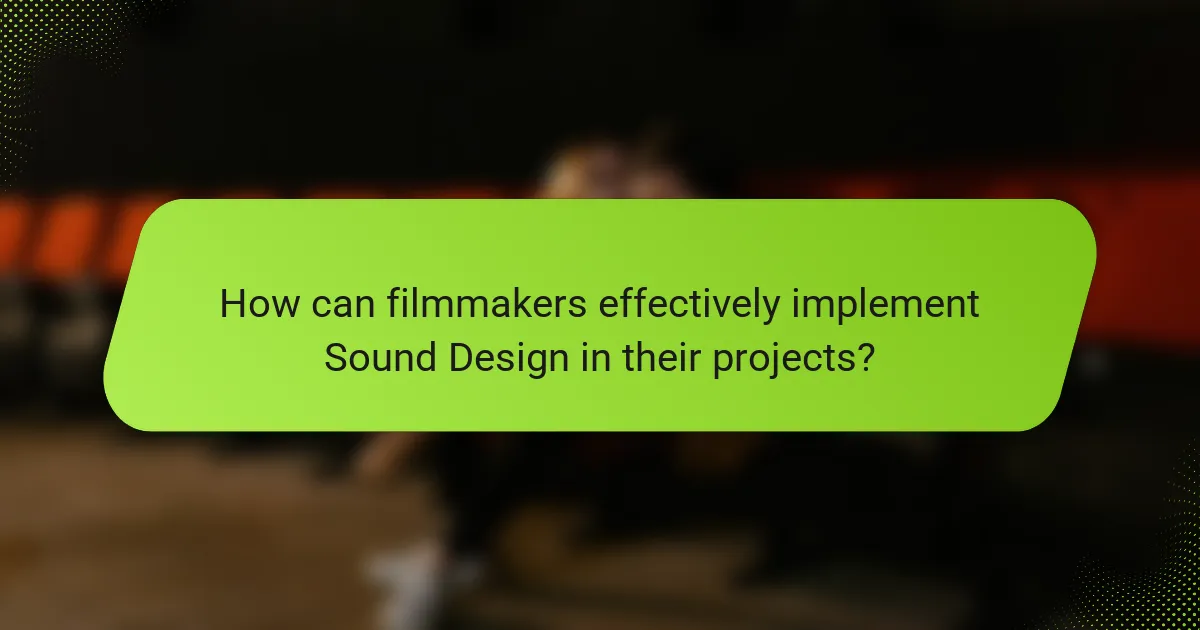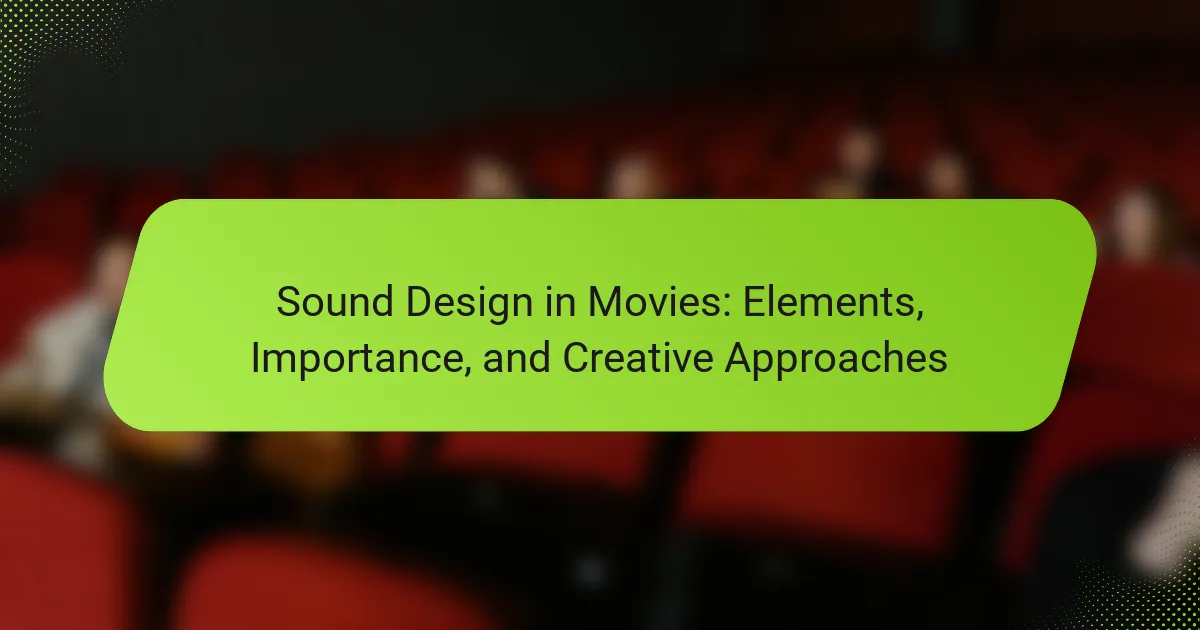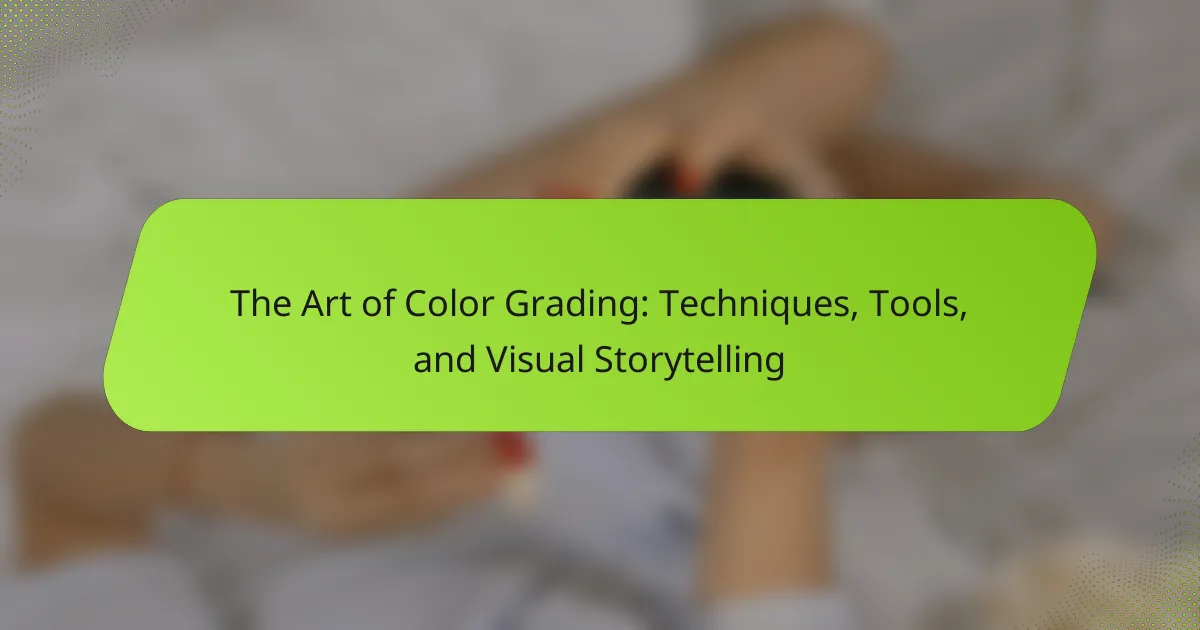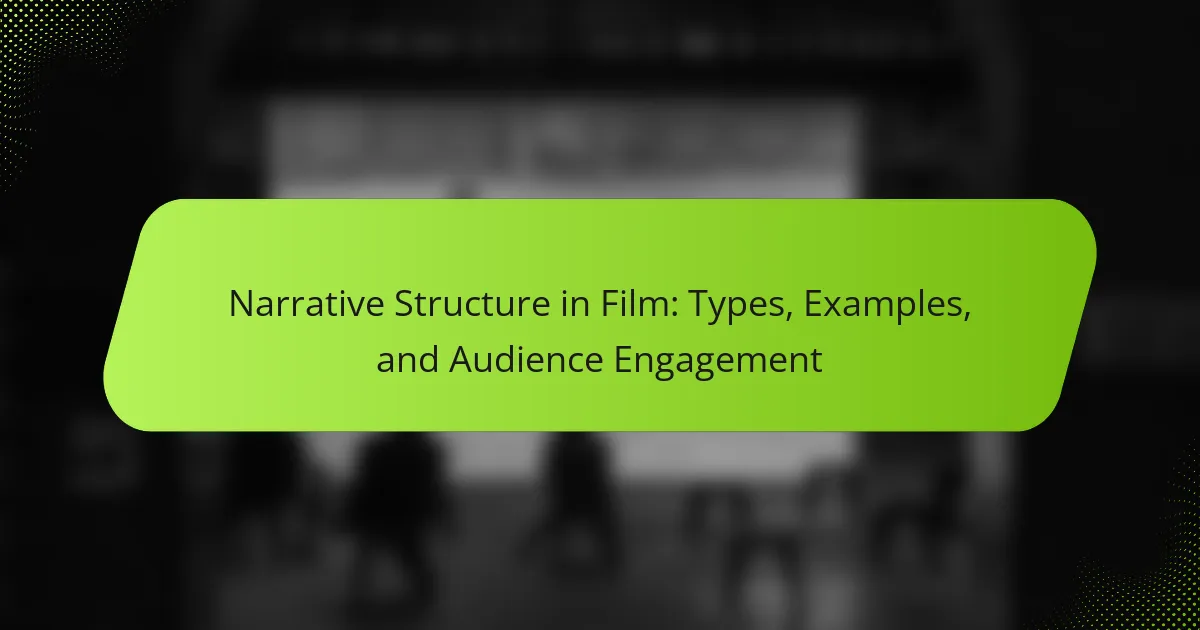
What is Sound Design in Movies?
Sound design in movies is the process of creating and manipulating audio elements to enhance the storytelling. It involves the combination of dialogue, sound effects, and music to create an immersive experience. Sound designers work to ensure that audio complements the visual elements of a film. They use various techniques to manipulate sounds, including recording, editing, and mixing. This process helps to convey emotions and set the tone of scenes. For instance, the sound of footsteps can create tension or urgency. Effective sound design can significantly impact audience engagement and perception. Studies have shown that well-executed sound design increases viewer immersion and emotional response.
How does Sound Design contribute to the overall film experience?
Sound design enhances the overall film experience by creating an immersive auditory environment. It establishes mood and emotion through the careful selection of sounds. For instance, background music can evoke feelings of tension or joy. Sound effects add realism, making scenes more believable. Dialogue clarity ensures that the story is easily understood. According to a study by the University of Southern California, sound design significantly impacts audience engagement. Effective sound design can increase emotional responses by up to 50%. In summary, sound design plays a crucial role in shaping how viewers perceive and connect with a film.
What are the key elements of Sound Design in movies?
The key elements of sound design in movies include dialogue, sound effects, foley, ambience, and music. Dialogue is crucial for conveying the story and character emotions. Sound effects enhance realism and support the visual narrative. Foley involves creating everyday sound effects to match the actions on screen. Ambience provides background sounds that establish the setting and mood. Music underscores emotional moments and can drive the narrative. Each element works together to create an immersive auditory experience.
How does Sound Design enhance storytelling in film?
Sound design enhances storytelling in film by creating an immersive auditory experience. It establishes mood and atmosphere, influencing audience emotions. Sound effects provide context, grounding the viewer in the film’s world. Dialogue clarity ensures character intentions are understood. Music scores evoke specific feelings, reinforcing narrative themes. Spatial audio techniques create a sense of place, guiding audience attention. Historical examples include the use of silence in “A Quiet Place” to heighten tension. Overall, sound design is essential for enriching the storytelling experience in film.
Why is Sound Design important in filmmaking?
Sound design is important in filmmaking because it enhances the storytelling experience. It creates an immersive environment for the audience. Sound design contributes to the emotional impact of a scene. It helps to establish mood and tone. Effective sound design can guide audience reactions. It can evoke feelings of tension, joy, or sadness. According to a study by the University of Southern California, sound significantly influences audience engagement. The right sound elements can make a film more memorable and impactful.
What impact does Sound Design have on audience engagement?
Sound design significantly enhances audience engagement by creating an immersive experience. It shapes the emotional response of viewers through auditory cues. For instance, specific sound effects can heighten tension or evoke nostalgia. Research shows that well-crafted soundscapes improve storytelling by reinforcing visual elements. According to a study published in the Journal of Media Psychology, sound design can increase viewer retention by up to 30%. This indicates that audiences are more likely to remember films with effective sound design. Overall, sound design is crucial for captivating and retaining audience attention in movies.
How does Sound Design influence the emotional tone of a film?
Sound design significantly influences the emotional tone of a film. It shapes audience perceptions and feelings through auditory elements. Sound effects, music, and dialogue contribute to mood and atmosphere. For example, high-pitched sounds can create tension, while soft melodies evoke nostalgia. The use of silence can heighten suspense or emphasize moments of reflection. Research indicates that sound can alter emotional responses; a study by the University of Southern California found that music affects viewers’ emotional engagement. Therefore, sound design is crucial in guiding audience emotions throughout a film.
What are the different types of Sound Design techniques used in movies?
There are several types of sound design techniques used in movies. These techniques include diegetic sound, non-diegetic sound, Foley sound, and sound effects. Diegetic sound is sound that originates from the film’s world, such as dialogue or ambient noise. Non-diegetic sound is added for effect, like a musical score or voiceover. Foley sound involves creating everyday sound effects in post-production to enhance realism. Sound effects are artificially created or enhanced sounds used to support the narrative. Each technique plays a crucial role in creating an immersive cinematic experience.
What role do sound effects play in Sound Design?
Sound effects play a crucial role in sound design by enhancing the auditory experience in movies. They contribute to storytelling by providing context and emotional depth. Sound effects create a sense of realism, making scenes more immersive for the audience. They also help to establish mood and atmosphere, influencing viewers’ emotional responses. Additionally, sound effects can signify actions or events, guiding audience attention. For example, a door creaking can indicate suspense. The strategic use of sound effects can elevate a film’s overall impact and engagement.
How is dialogue recorded and mixed in Sound Design?
Dialogue in sound design is recorded using high-quality microphones and audio interfaces. The recording typically occurs on set during filming or in a controlled studio environment. Sound engineers use directional microphones to capture clear dialogue while minimizing background noise.
After recording, dialogue is mixed using digital audio workstations (DAWs). Engineers adjust levels, apply equalization, and add effects like reverb for depth. Dialogue is also synchronized with visuals to ensure proper timing.
The mixing process often involves layering dialogue tracks to enhance clarity and presence. This meticulous approach ensures that dialogue is intelligible and blends seamlessly with other sound elements. Proper dialogue mixing is crucial for audience engagement and storytelling effectiveness in films.
What is the significance of music in Sound Design?
Music plays a crucial role in sound design by enhancing emotional impact. It sets the tone and atmosphere of a scene. Music can evoke specific feelings, guiding audience reactions. It aids in storytelling by reinforcing narrative elements. In films, music helps establish character identities and themes. Research shows that music influences memory retention and audience engagement. A study by the University of Southern California found that music significantly affects emotional responses in viewers. Thus, music is essential for creating immersive cinematic experiences.

What are the creative approaches to Sound Design in movies?
Creative approaches to sound design in movies include the use of diegetic and non-diegetic sounds. Diegetic sounds originate from the film’s world, like dialogue and ambient noise. Non-diegetic sounds, such as musical scores, enhance emotional impact. Layering sounds creates depth and realism in scenes. Foley artistry adds specific sound effects to match actions on screen. Soundscapes establish mood and atmosphere through ambient noise. Innovative use of silence can heighten tension and focus attention. Experimentation with sound manipulation techniques, like pitch shifting, adds uniqueness to the auditory experience. These methods contribute to storytelling and audience engagement in film.
How do sound designers collaborate with directors and other departments?
Sound designers collaborate with directors and other departments through continuous communication and creative meetings. They engage in discussions to understand the director’s vision and narrative goals. This collaboration ensures that sound complements the visual elements effectively. Sound designers also work closely with the cinematography team to synchronize audio with visual cues. They coordinate with the editing department to align sound effects with the pacing of scenes. Additionally, they may consult with the music department to integrate score and sound design harmoniously. This collaborative process enhances the overall storytelling experience in film.
What is the process of creating a soundscape for a film?
The process of creating a soundscape for a film involves several key steps. First, sound designers analyze the script and visuals. They identify the emotional tone and setting of each scene. Next, they gather or create sound effects, dialogue, and ambient sounds. This includes recording new sounds or sourcing from libraries. After collecting sounds, designers edit and mix them using digital audio workstations. They synchronize the audio with visuals to enhance storytelling. Finally, sound designers conduct test screenings to refine the soundscape based on audience feedback. This iterative process ensures that the soundscape effectively supports the film’s narrative and emotional impact.
How do sound designers utilize technology in their creative process?
Sound designers utilize technology to enhance audio elements in film production. They employ digital audio workstations (DAWs) for recording and editing sound. This software allows for precise manipulation of audio tracks. Sound designers also use sound libraries to source various sound effects. They incorporate synthesizers to create unique sounds that fit specific scenes. Additionally, they utilize plugins for effects like reverb and compression. Technology enables real-time collaboration among team members, improving workflow efficiency. Overall, technology is essential in shaping the auditory experience in films.
What innovative techniques are emerging in Sound Design?
Innovative techniques emerging in sound design include spatial audio technology and procedural sound generation. Spatial audio enhances the immersive experience by simulating sound from multiple directions. This technique uses advanced algorithms to create a three-dimensional sound field. Procedural sound generation creates unique audio effects in real-time based on parameters set by the designer. This allows for dynamic soundscapes that adapt to the scene’s context. Additionally, machine learning algorithms are being utilized to analyze and generate sound patterns. These techniques are transforming how sound is integrated into films, enhancing storytelling and audience engagement.
How is immersive audio changing the landscape of Sound Design?
Immersive audio is revolutionizing sound design by creating a more engaging and realistic auditory experience. This technology allows sound designers to place audio elements in a three-dimensional space, enhancing the listener’s perception of depth and direction. Traditional stereo sound limits audio to two channels, whereas immersive audio utilizes formats like Dolby Atmos, which supports up to 128 audio tracks. This capability enables sound designers to craft intricate soundscapes that respond dynamically to viewer movements and interactions. Research shows that immersive audio significantly improves audience immersion and emotional impact in films. A study conducted by the University of Southern California found that viewers rated their emotional engagement higher when exposed to immersive audio environments compared to standard formats. This shift towards immersive audio is reshaping how sound is integrated into storytelling, making it a vital component in modern sound design practices.
What is the role of virtual reality in modern Sound Design?
Virtual reality (VR) plays a transformative role in modern sound design. It enhances immersive experiences by creating spatial audio environments. Sound designers can manipulate audio elements in a three-dimensional space. This allows for realistic soundscapes that react to user interactions. VR technology enables the simulation of real-world acoustics. Users perceive sound from various directions and distances. This immersion increases emotional engagement with the content. Research indicates that 3D audio significantly improves user experience in VR settings.

How can filmmakers effectively implement Sound Design in their projects?
Filmmakers can effectively implement sound design by integrating it early in the production process. This includes collaborating with sound designers during pre-production to establish a clear vision. Utilizing location sound recording enhances authenticity and immerses the audience in the film’s environment. Layering sound elements, such as dialogue, sound effects, and music, creates a rich auditory experience.
Employing sound editing software allows for precise manipulation of audio tracks. Filmmakers should also prioritize sound mixing to ensure clarity and balance among audio components. Testing sound design in various environments helps gauge its impact. Research shows that sound design significantly influences audience emotions and engagement, as noted in studies by the University of Southern California.
What best practices should be followed in Sound Design for films?
Best practices in sound design for films include careful planning and organization. Sound designers should create a detailed sound map before production. This map outlines all required sound elements, ensuring nothing is overlooked. Recording high-quality sounds in controlled environments is crucial. Using professional microphones and equipment enhances sound clarity. Mixing and editing should occur in a well-treated acoustic space. This prevents unwanted reflections and noise. Collaboration with directors and other departments is essential for cohesive sound design. Regular feedback during the process helps refine the sound. Finally, sound designers should stay updated on technology and trends. This ensures the use of innovative techniques and tools.
How can filmmakers ensure sound quality in their productions?
Filmmakers can ensure sound quality in their productions by using high-quality recording equipment. This includes professional microphones and audio interfaces. Proper placement of microphones is crucial for capturing clear sound. Filmmakers should also monitor audio levels during recording. Using soundproof environments minimizes unwanted noise. Additionally, employing skilled sound engineers enhances overall sound quality. Post-production sound editing and mixing are essential for achieving a polished final product. Research indicates that high-quality sound significantly improves audience engagement and perception of film quality.
What common pitfalls should be avoided in Sound Design?
Common pitfalls to avoid in sound design include excessive layering of sounds. This can lead to a cluttered audio mix. Poorly balanced sound levels can overshadow important audio elements. Neglecting the importance of silence can disrupt the intended emotional impact. Failing to consider the acoustics of the environment can result in unrealistic sound placement. Overusing effects can detract from the authenticity of the sound. Ignoring the narrative context can lead to disjointed audio experiences. Lastly, not collaborating with the rest of the production team can hinder cohesive storytelling.
What resources are available for learning more about Sound Design?
Books on sound design are essential resources. “The Sound Effects Bible” by Ric Viers provides comprehensive insights. Online courses, such as those on Coursera and Udemy, offer structured learning. Websites like Sound on Sound feature articles and tutorials. Additionally, forums like Gearslutz allow for community interaction and advice. YouTube channels dedicated to sound design provide practical demonstrations. Podcasts, such as “The Sound Design Podcast,” offer interviews with industry professionals. These resources collectively enhance understanding and skills in sound design.
Where can aspiring sound designers find educational materials?
Aspiring sound designers can find educational materials through various online platforms. Websites like Coursera and Udemy offer courses specifically on sound design. Additionally, YouTube hosts numerous tutorials from industry professionals. Books on sound design are available at libraries and bookstores, providing in-depth knowledge. Online forums and communities, such as Reddit, allow for peer learning and resource sharing. Educational institutions often provide specialized programs in sound design, offering structured learning paths. These resources collectively support aspiring sound designers in developing their skills and knowledge.
What are some influential works in Sound Design to study?
Some influential works in Sound Design to study include “Star Wars” by Ben Burtt. This film revolutionized sound effects in cinema. Burtt created iconic sounds like the lightsaber and the TIE fighter. Another significant work is “Apocalypse Now” by Walter Murch. Murch’s innovative use of sound helped convey the film’s themes. “The Dark Knight,” with sound design by Richard King, also stands out. King crafted the intense soundscape that enhances the film’s tension. Additionally, “Inception” features sound design by Richard King, blending music and effects seamlessly. These works exemplify the impact of sound design on storytelling in film.
Sound design in movies is the process of creating and manipulating audio elements to enhance storytelling through dialogue, sound effects, and music. This article explores the key elements of sound design, its significance in filmmaking, and its impact on audience engagement and emotional tone. It covers various techniques used in sound design, the collaboration between sound designers and other departments, and emerging innovations such as immersive audio and virtual reality. Additionally, best practices for effective sound design implementation and resources for further learning are highlighted, providing a comprehensive overview of this essential aspect of filmmaking.



